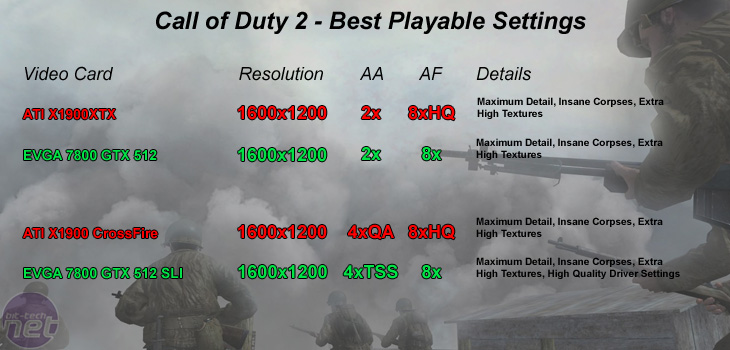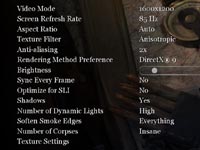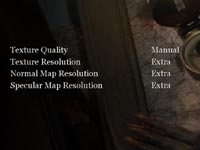Call of Duty 2:
Publisher: ActivisionWe used the full version of Call of Duty 2, patched to version 1.01. The game makes use of some awesome effects and is generally very graphically intense and immersive. That's helped by the tremendous smoke effect that Infinity Ward have created - it's better than anything we've ever seen before. There are also real time shadows and a subtle HDR lighting effect too.
The gameplay is not as linear as the first version of Call of Duty, and Infinity Ward has ditched the rather old Quake 3 engine in favour of creating its own proprietry graphics engine to render the effects. There is something about the game that makes it very intense and you often find yourself having to take a break from the action because you're too overwhelmed by its immersiveness and intensity.
We used a five minute portion of the first level in The Battle of El Alamein, starting the clock from the beginning of the battle, completing the missions in the same order, stopping the frame rate recording when we had played five minutes of the level. We made use of all four smoke grenades in our armoury at the start of the level and we ran this three times to check that our results were consistent. We found that an average frame rate of around 40 frames per second and a minimum of 20 frames per second was sufficient to experience a smooth gaming experience throughout the title.


The EVGA GeForce 7800 GTX 512 could play the game at the same settings, minus high quality texture filtering. The drivers were left at their default 'quality' setting too, meaning that the image quality wasn't quite on a par with the Radeon X1900XTX -- at least where texture filtering is concerned.
The Radeon X1900XTX also returned a higher average frame rate too - the minimum was slight lower on ATI's card, but the drop below 30 frames per second only occured on the occasion where the minimum frame rate was recorded, while the GTX 512 hovered around and slightly below 30 frames per second on a number of occasions at the highest playable settings.
Curiously, with CrossFire we had to enable the 'optimise for SLI' option in order to see decent performance improvements. After enabling the rather ironic SLI optimisation option, we were able to increase the AA quality to 4x quality adaptive antialiasing. The gameplay was tremendously smooth with an average frame rate approaching 60 fps and a minimum of 29. Quite fantastic.
On the other hand, the EVGA GeForce 7800 GTX 512 was able to play the game at 1600x1200 4x transparency supersampled antialiasing and 8x anisotropic filtering with high quality driver settings. The image quality was generally pretty good but unfortunately, the texture filtering let the cards down a little when compared to the high quality anisotropic filtering. Incidentally, the high quality anisotropic filtering setting was completely playable with both ATI's Radeon X1900XTX and when two X1900's are used together in CrossFire.

MSI MPG Velox 100R Chassis Review
October 14 2021 | 15:04









Want to comment? Please log in.